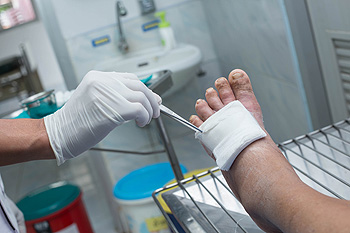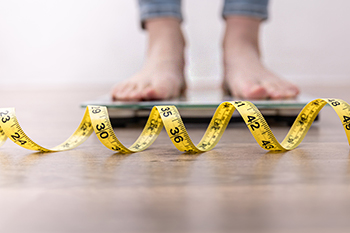Items filtered by date: July 2023
Understanding Foot Ulcers

Foot ulcers are open wounds on the feet resulting from skin breakdown. They may be deep, discolored sores that discharge pus, affecting deeper layers of the skin, and potentially spreading to muscles, tendons, or bones. Often caused by injury, friction, or pressure, ulcers are more likely to develop in people who have diabetes and peripheral neuropathy, which reduces foot sensation and can impede skin healing, raising ulcer risks. These ulcers can be painful. Untreated foot ulcers can lead to infections and complications and require serious medical intervention. To prevent ulcers, wear well-fitting shoes and regularly check your feet. If you have foot wounds, it is suggested that you seek prompt examination and treatment from a podiatrist.
Wound care is an important part in dealing with diabetes. If you have diabetes and a foot wound or would like more information about wound care for diabetics, consult with Elliot T. Udell, DPM from New York. Our doctor will assess your condition and provide you with quality foot and ankle treatment.
What Is Wound Care?
Wound care is the practice of taking proper care of a wound. This can range from the smallest to the largest of wounds. While everyone can benefit from proper wound care, it is much more important for diabetics. Diabetics often suffer from poor blood circulation which causes wounds to heal much slower than they would in a non-diabetic.
What Is the Importance of Wound Care?
While it may not seem apparent with small ulcers on the foot, for diabetics, any size ulcer can become infected. Diabetics often also suffer from neuropathy, or nerve loss. This means they might not even feel when they have an ulcer on their foot. If the wound becomes severely infected, amputation may be necessary. Therefore, it is of the upmost importance to properly care for any and all foot wounds.
How to Care for Wounds
The best way to care for foot wounds is to prevent them. For diabetics, this means daily inspections of the feet for any signs of abnormalities or ulcers. It is also recommended to see a podiatrist several times a year for a foot inspection. If you do have an ulcer, run the wound under water to clear dirt from the wound; then apply antibiotic ointment to the wound and cover with a bandage. Bandages should be changed daily and keeping pressure off the wound is smart. It is advised to see a podiatrist, who can keep an eye on it.
If you have any questions, please feel free to contact our office located in Hicksville, NY . We offer the newest diagnostic and treatment technologies for all your foot care needs.
How Can Being Overweight Affect the Feet?

The feet are the foundation of the body, carrying its weight with every step. When someone is obese, the added force on the feet can take its toll, and foot problems easily emerge. Obesity, which has become a national problem, can negatively affect the structure of your feet. Excess weight can weaken the arches, which both support your body and absorb shock. As the arch becomes less effective, flat feet are likely to develop, and added stress is placed on the plantar fascia under the foot. When this band of tissue suffers from overuse, a painful condition known as plantar fasciitis develops, causing inflammation. Obesity can also cause damage to the nerves and muscles in the feet, which can affect the ability to walk. In addition, the risk of developing Achilles tendonitis and osteoarthritis increase with added body weight. Not only that, but the weakening of the heel can contribute to instability and increase the possibility of ankle injury or falling. If you have weight-related foot problems, it is suggested that you make an appointment with a podiatrist for testing and treatment options.
The more you weigh, the harder your feet must work to support your body. If you’re an obese individual and are concerned about your feet, contact Elliot T. Udell, DPM from New York. Our doctor can provide the care you need to keep you pain-free and on your feet.
Obesity and Your Feet
People who are overweight are putting more pressure on their ankles, knees, and hips as well as their feet. This unfortunately can lead to variety of different issues.
Problems & Complications Stemming from Obesity
- When the body is overweight, it tries to compensate by changing the way that it moves. An obese person may lean forward and put extra weight on the wrong part of the foot. This puts unnecessary stress on the feet.
- Obese people are also more likely to develop type II diabetes which is a condition that causes a lot of foot problems. People with diabetes often don’t feel the cuts and sores that they may have on their feet, which can lead to more complicated and severe issues.
- Plantar fasciitis is another foot condition that can be caused by obesity. Plantar fasciitis is an inflammation of the tissue along the bottom of the foot, which causes pain and stiffness while walking and climbing stairs.
If you have any questions, please feel free to contact our office located in Hicksville, NY . We offer the newest diagnostic and treatment technologies for all your foot care needs.
Aging Affects the Feet

As one ages, their feet also age. A common sign of aging feet is the inability to absorb impact, also termed a loss of springiness. This is the result of loosening of the tendons that hold the arch in place. Additionally, the joints can become less flexible as one ages, especially if osteoarthritis sets in, further reducing the flexibility of the feet. Rheumatoid arthritis, gout, and obesity are other factors that may affect the foot’s suppleness. Another effect of aging is decreased muscle strength. Add to that a natural thinning of the bones, which can become worse by smoking and not intaking adequate vitamin D amounts. This increases the chance of getting stress fractures. Another way that aging affects the feet is a loss of resilience in the skin, which reduces its cushioning. Furthermore, the fat pads, particularly under the ball of the foot and the heel begin to thin out, increasing the chances of having foot pain. Wearing proper footwear is generally the easiest way to lessen the effects of aging on the feet. Shoes with ample cushioning and arch support are essential. For help with foot problems caused by aging, it is suggested that you make an appointment with a podiatrist.
Proper foot care is something many older adults forget to consider. If you have any concerns about your feet and ankles, contact Elliot T. Udell, DPM from New York. Our doctor can provide the care you need to keep you pain-free and on your feet.
The Elderly and Their Feet
As we age we start to notice many changes in our body, but the elder population may not notice them right away. Medical conditions may prevent the elderly to take notice of their foot health right away. Poor vision is a lead contributor to not taking action for the elderly.
Common Conditions
- Neuropathy – can reduce feeling in the feet and can hide many life-threatening medical conditions.
- Reduced flexibility – prevents the ability of proper toenail trimming, and foot cleaning. If left untreated, it may lead to further medical issues.
- Foot sores – amongst the older population can be serious before they are discovered. Some of the problematic conditions they may face are:
- Gouging toenails affecting nearby toe
- Shoes that don’t fit properly
- Pressure sores
- Loss of circulation in legs & feet
- Edema & swelling of feet and ankles
Susceptible Infections
Diabetes and poor circulation can cause general loss of sensitivity over the years, turning a simple cut into a serious issue.
If you have any questions please feel free to contact our office located in Hicksville, NY . We offer the newest diagnostic and treatment technologies for all your foot and ankle needs.
Exercises for Flat Feet

Children are naturally born with flat feet, and by the time they are teenagers, the arch usually develops normally. However, there are various circumstances where the arches either do not develop or they fall. These include injuries, obesity, genetics, and arthritis. Those with neurological or muscular diseases may also be more prone to having flat feet. Wearing orthotics or arch supports, and performing certain stretches, can reduce pain from fallen arches or help correct them. Examples of exercises that might help raise, strengthen, and lengthen the arches are heel stretches and tennis or golf ball rolls. Stretch your heels by standing with your hands resting on a wall at eye level. Keep one leg forward and the other extended behind you. Press both heels into the floor. Then bend one leg at a time toward the wall with the opposite heel pressed into the floor and hold this position for 30 seconds. Repeat on each side four times. For the tennis or golf ball roll, sit in a chair with a ball under one foot. Keep a straight spine and roll the ball under your foot, focusing on the arch. Do this for two to three minutes and then change feet. If you have flat feet and they are causing you discomfort, it is suggested that you consult with a podiatrist who can provide you with additional exercise options and further treatment that is right for you.
Flatfoot is a condition many people suffer from. If you have flat feet, contact Elliot T. Udell, DPM from New York. Our doctor will treat your foot and ankle needs.
What Are Flat Feet?
Flatfoot is a condition in which the arch of the foot is depressed and the sole of the foot is almost completely in contact with the ground. About 20-30% of the population generally has flat feet because their arches never formed during growth.
Conditions & Problems:
Having flat feet makes it difficult to run or walk because of the stress placed on the ankles.
Alignment – The general alignment of your legs can be disrupted, because the ankles move inward which can cause major discomfort.
Knees – If you have complications with your knees, flat feet can be a contributor to arthritis in that area.
Symptoms
- Pain around the heel or arch area
- Trouble standing on the tip toe
- Swelling around the inside of the ankle
- Flat look to one or both feet
- Having your shoes feel uneven when worn
Treatment
If you are experiencing pain and stress on the foot you may weaken the posterior tibial tendon, which runs around the inside of the ankle.
If you have any questions please feel free to contact our office located in Hicksville, NY . We offer the newest diagnostic and treatment technologies for all your foot and ankle needs.

